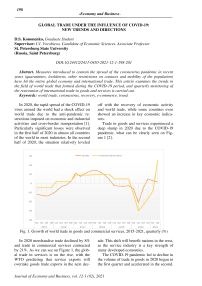Global trade under the influence of COVID-19: new trends and directions
Автор: Kononenko D.S.
Журнал: Экономика и бизнес: теория и практика @economyandbusiness
Статья в выпуске: 12-1 (82), 2021 года.
Бесплатный доступ
Measures introduced to contain the spread of the coronavirus pandemic in recent years (quarantines, lockdowns, other restrictions on contacts and mobility of the population) have hit the entire global economy and international trade. This article examines the trends in the field of world trade that formed during the COVID-19 period, and quarterly monitoring of the restoration of international trade in goods and services is carried out.
World trade, coronavirus, recovery, e-commerce, trend
Короткий адрес: https://sciup.org/170191926
IDR: 170191926
Текст научной статьи Global trade under the influence of COVID-19: new trends and directions
In 2020, the rapid spread of the COVID-19 virus around the world had a shock effect on world trade due to the anti-pandemic restrictions imposed on economic and industrial activities and cross-border transportation [1]. Particularly significant losses were observed in the first half of 2020 in almost all countries of the world in most industries. In the second half of 2020, the situation relatively leveled off with the recovery of economic activity and world trade, while some countries even showed an increase in key economic indicators.
Trade in goods and services experienced a deep slump in 2020 due to the COVID-19 pandemic, what can be clearly seen on Figure 1 [2].
Fig. 1. Growth of world trade in goods and commercial services, 2015-2021, quarterly (%)
In 2020 merchandise trade declined by 8% and trade in commercial services contracted by 21%. As we can see on Figure 1, the global trade in services is on the rise, with the WTO predicting that service exports will overtake goods trade exports in the next dec- ade. This shift will benefit nations in the west, as the service industry is a key strength of many developed economies.
The COVID-19 pandemic led to decline in the volume of trade in goods in 2020 began in the first quarter and accelerated in the second.
The effect of COVID-19 on goods and services differed, with services more severely affected. Services declined by 30% in the second quarter of 2020 compared with a fall of 23% for goods in the same period. But already in the third quarter, global trade turnover increased sharply by 11.4% compared to the previous quarter and then by another 4.4% in fourth quarter 2020, as a result of which the volume of trade returned to its pre-crisis level. During first two quarters 2021 it is clearly seen rapid growth in both goods and services, but mostly in services. Global services trade returned to positive growth in the second quarter of 2021, rising by 26%. The increase largely reflected the rebound from second quarter 2020, the quarter in which the strongest impact due to COVID-19 was felt.
The decline in merchandise trade in 2020 was less severe than forecasters predicted for a number of reasons. These included proactive fiscal and monetary policies that boosted incomes and consumption, an increase in demand for technological innovation to facilitate remote work, and trade policy restraint that kept supply chains functioning.
Despite the panic that the world plunged into during the pandemic, the global economy is recovering faster than expected thanks to vaccination and the lifting of restrictive measures. Economic recovery from COVID-19 had been started from the second half of 2020 (Figure 2) [3].
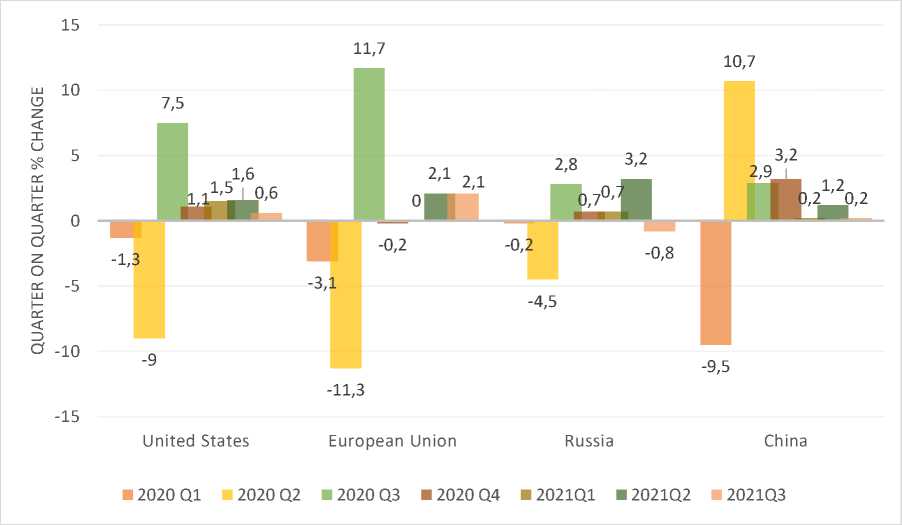
Fig. 2. Real GDP growth of selected economies, 2020Q1 – 2021Q3 (%)
GDP growth slowed in major economies in the first quarter of 2021 as new waves of infection prompted new lockdowns and travel restrictions [4]. But situation had been changed in second and third quarters – GDP almost in all countries shown on Figure 1 started to grows again. GDP growth in the United States rose to 1.6% in the first quarter of 2021 compared with the previous quarter. This is equivalent to around 6.5 per cent on an annualized basis. Meanwhile, EU GDP contracted by 0 per cent in the first quarter as the virus resurged in the region. Russia’s economy grew by 0.7 per cent in the fourth quarter of 2020 and continue to grow in second and third quarters despite on new coronavirus wave.
The current crisis related to COVID-19 has contributed to the formation of a special format of consumption in terms of expenses, categories of purchased goods, sales channels and purchasing strategies. Analysis of the features of the spread of COVID-19 in different countries of the world shows that as the number of cases increases and restrictive measures are introduced, consumer demand has gone through six stages of transformation:
-
1. Growing demand for health-supporting products.
-
2. Consumers are stocking up on goods needed to limit the spread of the virus.
-
3. Purchase of durable goods storage.
-
4. The emergence of interest in online sales, difficulties in the supply chain.
-
5. Limiting shopping trips, explosive growth of online sales.
-
6. Changing logistics processes, the role of online commerce (a lot of people began to prefer online shopping to offline) and sanitary standards.
In the last three stages, there is clearly a new trend of online shopping. Consumers around the world began to prefer this format of purchases, because it significantly saves time, allows you to find a detailed description and reviews of other customers.
The influx of new customers, optimization of business processes of online and offline stores, new product presentation formats have become a catalyst for the growth of online commerce. However, this segment has not yet reached its peak and continues to grow continuously (Figure 3) [5].
■ Online ■ Offline
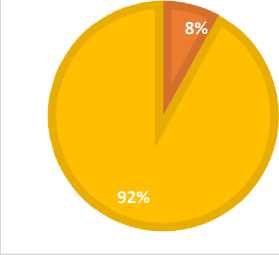
■ Online ■ Offline
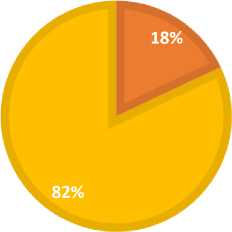
Fig. 3. Global retail market size in 2015, 2020, 2021 (%)
■ Online ■ Offline
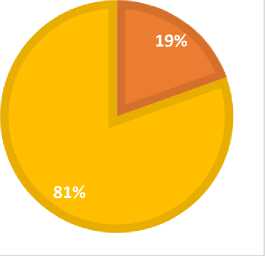
Thus, the position of e-commerce in the world will only grow. In this regard, new strategic solutions are emerging in the field of trade, such as the creation of special ecommerce trading zones.
China became the first country to launch such a project. Special e-commerce zones are a system of preferences and simplified document management, customs clearance for cross-border trade through e-commerce. Such zones are already functioning in 37 cities of China, which contributes to the liberalization and facilitation of international online trade between countries. The success of the PRC is already being accepted by a number of West- ern countries, and an increasing number of multinational corporations and international brands are attracting interest in this format of trade.
One more trend in trade after pandemic can be localization of trade. The pandemic has shown that global supply chains and production divided between many countries carry risks. Quarantine and economic restrictions at one point can lead to the shutdown of the entire production process. The transfer of chains to the local level, with greater synchronization of the economic cycle, reduces these risks, but reduces international trade. The alternative is to geographically diversify the supply of manufacturing components, which increases trade flows.
Free trade zones significantly increase trade turnover between member countries and, as a rule, reduce trade with non-member economies. Negotiations between a small number of participants are more likely to lead to success than decades-long multilateral negotiations within the WTO [6].
Thus, the coronavirus pandemic has really become a serious shock to world trade and the financial system as a whole. Describing the trends in the global trade turnover formed during the COVID-19 period, it is necessary to note the acceleration of the digitalization of the economy and production, the formation of special e-commerce zones, as well as the emphasis on the localization of trade in some countries.
Список литературы Global trade under the influence of COVID-19: new trends and directions
- Ерохин В.Л. Мировая торговля и рынки в 2020-2021 гг. под влиянием пандемии COVID-19 // Маркетинг и логистика. - 2021. - №4 (36). - С. 10-22.
- EDN: LVYITT
- The Organisation for Economic Co-operation and Development (OECD) statistic. - [Электронный ресурс]. - Режим доступа: https://www.oecd.org/(дата обращения: 28.12.2021).
- WTO data. - [Электронный ресурс]. - Режим доступа: https://data.wto.org/en (дата обращения: 28.12.2021).
- World Trade Statistical Review 2021. - [Электронный ресурс]. - Режим доступа: https://www.wto.org/english/res_e/statis_e/wts2021_e/wts2021_e.pdf (дата обращения: 28.12.2021).
- E-commerce share of total global retail sales from 2015 to 2024. - [Электронный ресурс]. - Режим доступа: https://www.statista.com/statistics/534123/e-commerce-share-of-retail-sales-worldwide/(дата обращения: 28.12.2021).
- Как изменятся мировые рынки после пандемии. - [Электронный ресурс]. - Режим доступа: https://www.forbes.ru/finansy-i-investicii/436363-zhelanie-torgovat-kak-izmenyatsya-mirovye-rynki-posle-pandemii (дата обращения: 28.12.2021).

